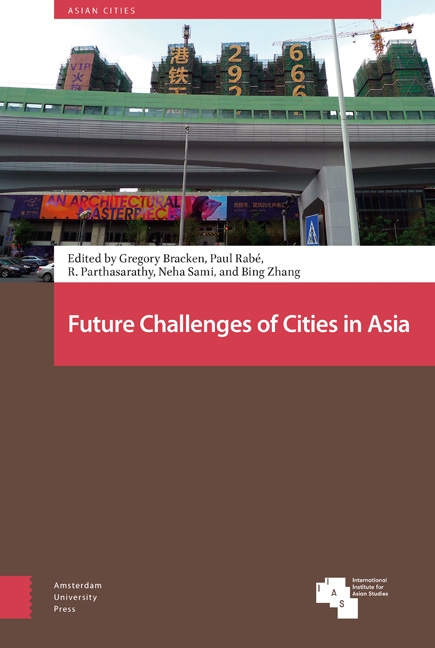Book contents
- Frontmatter
- About the Three UKNA Volumes
- Contents
- List of Figures and Tables
- 1 Future Challenges of Cities in Asia: An Introduction
- 2 Human Agency in the Asian City
- 3 Toward Inclusive, Vital and Livable City Scenarios: The Transformation of Urban Villages in Shenzhen
- 4 Cultural Dilemma in Beijing's Urban Regeneration: From Liulichang Cultural Street to Qianmen Street and Yangmeizhu Oblique Street
- 5 Housing as Heritage: The Great Urban Dilemma of the Global City of Shanghai
- 6 Not an Act of God: Lessons from a Disaster in the Settlements Planning of a River City
- 7 The Political Ecology of Climate Injustice in Bangkok
- 8 Assessing Flood-Related Vulnerability of the Urban Poor
- 9 The Ecological Future of Cities: Evaluating the Role of Green Infrastructure in Promoting Sustainability/Resilience in India
- 10 Hong Kong's “Rail-plus-Property” Development: A Model for Financing Public Transportation in Developing Cities in Southeast Asia?
- 11 Large Infrastructure Projects: The Emergence of Corridors in Asia
- Index
- Publications / Asian Cities
8 - Assessing Flood-Related Vulnerability of the Urban Poor
Published online by Cambridge University Press: 21 November 2020
- Frontmatter
- About the Three UKNA Volumes
- Contents
- List of Figures and Tables
- 1 Future Challenges of Cities in Asia: An Introduction
- 2 Human Agency in the Asian City
- 3 Toward Inclusive, Vital and Livable City Scenarios: The Transformation of Urban Villages in Shenzhen
- 4 Cultural Dilemma in Beijing's Urban Regeneration: From Liulichang Cultural Street to Qianmen Street and Yangmeizhu Oblique Street
- 5 Housing as Heritage: The Great Urban Dilemma of the Global City of Shanghai
- 6 Not an Act of God: Lessons from a Disaster in the Settlements Planning of a River City
- 7 The Political Ecology of Climate Injustice in Bangkok
- 8 Assessing Flood-Related Vulnerability of the Urban Poor
- 9 The Ecological Future of Cities: Evaluating the Role of Green Infrastructure in Promoting Sustainability/Resilience in India
- 10 Hong Kong's “Rail-plus-Property” Development: A Model for Financing Public Transportation in Developing Cities in Southeast Asia?
- 11 Large Infrastructure Projects: The Emergence of Corridors in Asia
- Index
- Publications / Asian Cities
Summary
Abstract
Urban poverty and floods are the foremost challenges for coastal cities of Southeast Asia. It is often assumed that the poor residents of a flood-affected area are mainly vulnerable. Yet, only few studies have placed flood-experienced people at the center of the vulnerability assessment. This chapter aims to explore who is vulnerable among the flood-affected urban poor and how they define flood-related vulnerability. We found that kampung residents use their flood experiences as a stock of knowledge to differentiate the level of vulnerability. Therefore, we suggest applying a life-world analysis to assess the state of vulnerability of an informal urban settlement and expect to identify the potentiality of the flood-experienced ones to organize transformative adaptation.
Keywords: flood, vulnerability, Jakarta, Indonesia, life-world
Introduction
Urban vulnerability is a conditional state that differs among cities while determining their adaptation pathways. As climate change is debated around the world, the slow onset and rapid changes, especially those occurring in tropical coastal regions, have increased urban vulnerability. This evolving discourse has attracted the attention of scholars from a variety of disciplines. Most of the scholars agree on the importance of knowing the state of climate-related vulnerability in urban development. Fuchs (2010) has predicted that Asia's at-risk urban population will reach 2.4 billion by 2030. Most of the affected people will be the urban poor, living in the most vulnerable locations.
The urban poor are unique in their capacity for producing space for living, such as the kampung2 in Indonesia. Kampung is the informal, traditional, self-organized settlement that still can exist in the modern living space of Indonesian cities (cf. Jellinek 1999; Kenworthy 1997). The hallmarks of the kampung are a densely populated area, inhabited mainly (but not solely) by poor people suffering from limited access to utilities and other public services (Marcussen 1990). In Jakarta, there are an estimated 600 kampung settlements (Kompas 2010). There are 490 pockets of poverty in Jakarta, which are associated with the presence of kampung (UN Habitat 2003). “It is estimated that 20 to 25 percent of Jakarta residents live in kampungs, with an additional four to five per cent squatting illegally along riverbanks, empty lots and floodplains” (UN Habitat 2003). The vulnerability of kampungs has exposed them to climate-related disasters, especially to flooding due to heavy rainfall, the rising sea level, and tidal flooding (Firman et al. 2011).
- Type
- Chapter
- Information
- Future Challenges of Cities in Asia , pp. 183 - 208Publisher: Amsterdam University PressPrint publication year: 2019



